Utopia
back to Focal
back to measurements
home
Published: Jul-15-2017
NO SMOOTHING is applied to the shown plots. Most measurement sites have some smoothing applied which ‘irons flat’ sharp peaks and ‘wiggles’. I do not use smoothing because some info about sound quality is lost when plots are smoothed.
Aside from a small correction of the microphone itself also some correction in the lowest frequencies is applied to the plots to compensate for the perceived loss of bass when using headphones. This is described HERE in more detail.
A ‘horizontal‘ frequency response curve on the shown frequency response plots on this website thus indicates a perceived ‘flat’ tonal signature.
ALL measurements are made with a good SEAL on a flatbed measurement rig.
The shape of your head, bone structure, pad size, pad ‘softness, (compliance), hair or no hair and or wearing glasses may (drastically) change the frequency response of some headphones, so… your personal experience may differ substantially from these plots.
Frequency response (tonal balance) is the most sound-determining aspect of headphones. A horizontal line shows audible neutral response in the plots on this website. Deviations in different severities at different frequency bands have an effect on the sound character.
The bigger the deviation the stronger the effect.
Below an aid to help determining the sound character of headphones with relation to the frequency response.

Focal Utopia

The Focal Utopia is an open over-ear dynamic headphone. It is the more expensive sibling of the Elear. It retails for around € 4000.-. This is not a cheap headphone for sure. The build quality is top notch. High quality/tech materials are used throughout. The comfort is quite high when you are willing to overlook the weight and the long and thick cable. The cable can be replaced though by after-market ones. It has locking Lemo connectors in each cup.
specifications:
Type: Over ear, open
Usage: Home
Driver type: dynamic, Beryllium dome.
Pads: replaceable perforated Lambskin + microfiber with memory-foam
Foldable: No
Headphone cup connector: Lemo FGG.0B.302.CLAD52
Cable entry: dual sided
Cable: 3m 6.3mm TRS to 2x Lemo
Driver size: 40mm
Max power rating: Not specified
Max. S.P.L.: Not specified
Impedance: 80 Ω
Efficiency: 98dB @ 1mW
Sensitivity: 109dB @ 1V
Weight: 490 g.
Clamping force: Medium
Accessories: manual, warranty card, carry case
Measurements:
Below the frequency response of the Utopia (Left, Right)
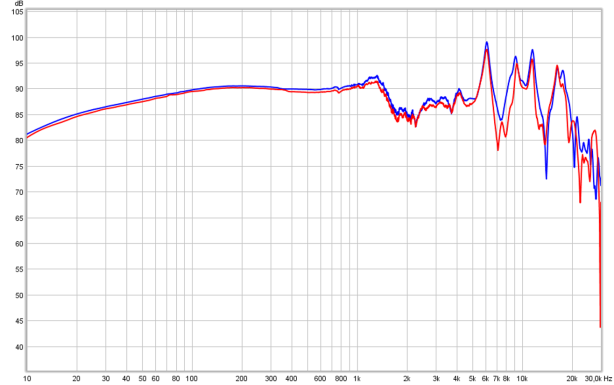
Channel matching is excellent as it should be at this price-point. From 100Hz to 1.5kHz it is impressively neutral without any peaks or dips. There is a gradual roll-off below 100Hz which is audible as being slightly on the lean side of things. No thunderous bass here but nice and tight and very dynamic. The upper mids aren’t recessed like with the Elear. The actual dip around 3kHz is probably slightly less then what the plot shows because of the lack of a Pinna and the drivers being angled.
The treble has a slight ‘boost’ to it at certain frequencies which makes some instruments can have an un-natural (small) accent to it.
It is very detailed sounding though and not rolled-off in the treble or boosted sounding like the HD800 and has plenty or ‘air’.
The treble peak around 6kHz can give sibilance/sharpness and can be removed with a passive filter.
The Elear is the smaller and much less expensive sibling of the Utopia. Often they are mentioned in the same sentence. For this reason alone it stands to reason to compare them. Below the Elear and Utopia level matched in the mids.
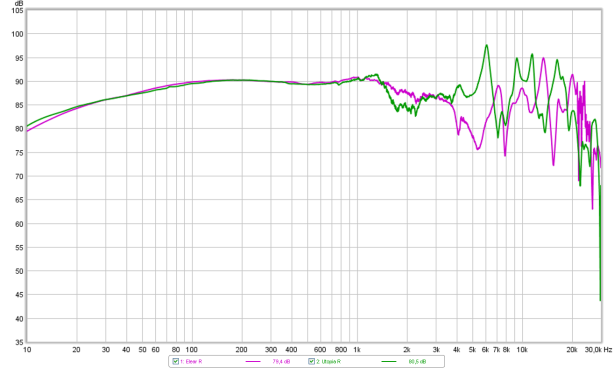
Above 7kHz is is kind-off hard to see the average tonal balance differences between these 2 models. For this reason the same plot below but 1/3 octave smoothed.

What is obvious here is that from 10Hz to 1.5kHz these are exactly the same. Above 1.5kHz differences are clearer. The tonal balance of the Utopia shows more clarity/presence and a more realistic treble level. The average tonal balance of the Elear thus can be seen as ‘darker’ as in ‘less clarity’.
The Utopia is also often ‘compared’ to the HD800. Quite logical as both are flagships (not counting the Orpheus-es) and both share some traits like slightly rolled off subbass, great mids, dynamic sound and highly detailed. Below the HD800 vs Utopia.
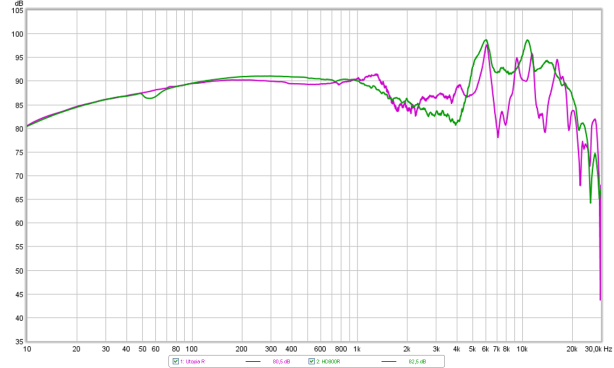
Both have a very similar response all the way up to 2kHz. For both headphones the dip around 3kHz will be smaller in reality. This is because my test-rig does not have a Pinna and the Concha-gain of the Pinna will ‘boost’ frequencies in that area.
Both have ‘peaks’ at 6kHz which can make instruments appear ‘overly’ detailed and a bit ‘sharpish’. Both headphones also show a peak at around 11kHz and have a similar treble extension. Still the HD800 sounds a lot ‘brighter’ in the treble. Where some people throw the towel in the ring with the HD800 treble the Utopia may not.
The reason for this is more obvious when the plots are 1/3 octave smoothed which shows a bit better how we perceive the tonal balance as it ‘irons’ flat the peaks.
Below the tonal balance difference between the Utopia and HD800.
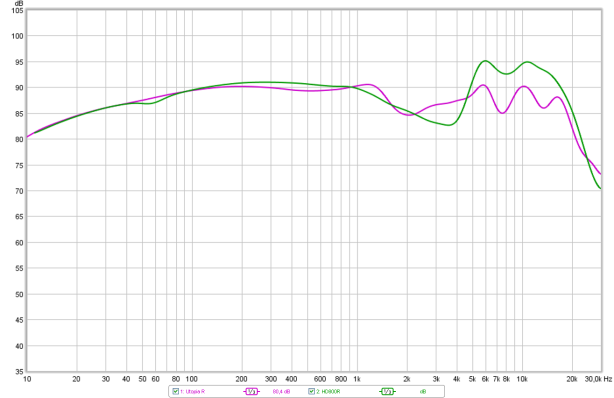
Now it becomes much more evident that the HD800 has a lot more (+5dB) treble energy than the Utopia which is more tonally balanced.
The Utopia is 3x more expensive than the HD800 though. The HD800 also has the benefit of being much lighter in weight and being more comfortable.
Personally I (just slightly) prefer the HD800 on the Kameleon over the Utopia (without Kameleon. Below a comparison between HD800 (on Kameleon) and Utopia.
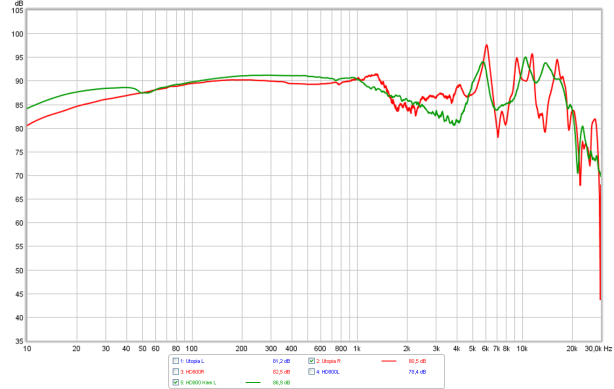
About 5dB more sub-bass and less peaky treble with the same tonal balance in the treble.
Of course the HD800 with EQ or something like Sonarworks (if you want digital sound manipulation) will have the same effect.
The HD800 + EQ outperforms the Utopia in sound quality and comfort for a much lower price in my opinion.
output resistance / damping-factor
As this is a dynamic headphone the frequency response might be amplifier output resistance dependent when certain higher output resistance amplifiers are used.
To test this the headphone is measured via a low impedance amplifier (0.2Ω) and a high impedance amplifier (120Ω). On a higher output resistance amplifier the output level will be considerably lower. To compensate for this the amplifier is cranked up to the same level (at 1kHz) as the low impedance amplifier. This way the plots are overlay-ed and it is easy to see how the tonal balance changes.

As can be seen the tonal balance changes considerably when connected to a higher output resistance amplifier. You get about 5dB more bass and a slightly ‘fuller’ bass.
When you would like a little more bass (not sub-bass) you could connect this headphone to a higher output resistance amplifier. Of course the amount of bass boost depends on the value of the amplifiers output resistance.
For the most neutral sound the output resistance should be between 0Ω and 10Ω.
Below the distortion plots of the Utopia : (only Right channel shown)
Note that this headphone was measured at ![]() where background noises were present in the demo room. As this is an open headphone distortion levels and spectrum plot performance may thus be better in reality than as shown on the plots.
where background noises were present in the demo room. As this is an open headphone distortion levels and spectrum plot performance may thus be better in reality than as shown on the plots.
The distortion products are shown in dB (Left channel).

The distortion is very low, most certainly for a medium sized dynamic driver.
If only all headphones could perform this well !
Distortion levels in the bass below 0.5% is excellent. Remember, distortion levels may be lower than shown because of measurement circumstances. The Utopia shows 2 small (and very low) peaks around 6kHz and 11kHz which the Elear doesn’t have.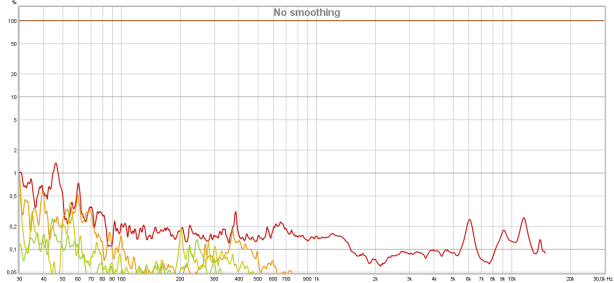
Below the CSD of the Utopia (Left and Right channel are superimposed)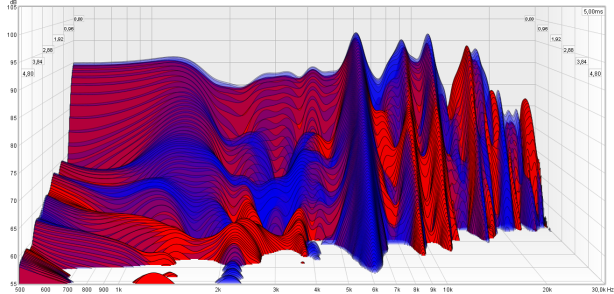
The CSD shows a very well controlled behavior up to 5kHz. At around 6kHz there is quite some ringing. This ringing combined with the small peak in amplitude are the main reasons this headphone has that small ‘accentuated’ thing in some recordings. At higher frequencies some small resonances show as well but much shorter lived.
Below the spectrum plot of the Utopia (Left channel)
The ‘noise’ between 1kHz and 4kHz is (most likely) picked up from the demo room it was measured in (around 40-45dB SPL background noise) because this is an open headphone. Aside from the issues around 6kHz and 11kHz the plot seems fine.
By lack of oscilloscope shots (not enough time to measure that) below a step response plot of the Utopia (Left channel)
The step response clearly shows the lack of ‘body/grunt/bottom end’ as evidenced by the downwards sloping horizontal line. There is no overshoot but the rising edge is followed by some (small level) ringing at various frequencies which doesn’t seem to be damped that well. Even after 3ms it is still ‘ringing’ a bit. Most likely this is caused by the stiffness of the metal used in the transducer. Other (softer) materials may well damp better.
It is pointless to show the right channel as it is measuring similar.
The Utopia is not performing as well here as it’s cheaper sibling Elear which seems better damped.
summary
This headphone is top notch when it comes to build quality and feel. The cable, however, is an abomination to me. When you have forked out 4k€ I would recommend to get a good after-market cable as well.
The fit however is nice but the weight is a bit high which may be an issue for some.
It’s all about the sound though. This is a very dynamic and ‘open’ sounding headphone.
The tonal balance is almost perfect. It could do with a bit more sub-bass/grunt. For the retail price you could look elsewhere. Good alternatives could be the better Stax electrostats (same subbass issue), the HIFIMAN HE1000 or HD800 with some EQ/Kameleon.
The (slight) lack of sub-bass/’grunt’ may not be an issue for most people. Bass is excellent and tight. The treble sometimes adds a sharp-ish accent to some instruments (the 6kHz issue). The treble peak around 6kHz can give sibilance/sharpness and can be removed with a passive filter.
My advise when thinking about buying this headphone is to try to audition (with it your own music, not demo music from the shop) OR make sure you can send it back after trying it for at least a few days.
This headphone ‘impresses’ immediately but the 6kHz issue may take a bit longer to reveal itself.
One of the most neutral/realistic and ‘dynamic’ headphones around and top-class.
